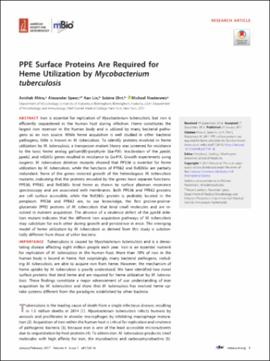| dc.contributor.author | Mitra, Avishek | |
| dc.contributor.author | Speer, Alexander | |
| dc.contributor.author | Lin, Kan | |
| dc.contributor.author | Ehrt, Sabine | |
| dc.contributor.author | Niederweis, Michael | |
| dc.contributor.editor | Stallings, Christina L | |
| dc.date.accessioned | 2023-02-16T16:47:43Z | |
| dc.date.available | 2023-02-16T16:47:43Z | |
| dc.date.issued | 2017-03-08 | |
| dc.identifier.citation | Mitra, A., Speer, A., Lin, K., Ehrt, S., Niederweis, M. (2017). PPE Surface Proteins Are Required for Heme Utilization by Mycobacterium tuberculosis. mBio, 8(1), pp. e01720-e01716. https://doi.org/10.1128/mbio.01720-16 | |
| dc.identifier.issn | 2161-2129 | |
| dc.identifier.uri | https://hdl.handle.net/11244/337040 | |
| dc.description.abstract | Iron is essential for replication of Mycobacterium tuberculosis, but iron is efficiently sequestered in the human host during infection. Heme constitutes the largest iron reservoir in the human body and is utilized by many bacterial pathogens as an iron source. While heme acquisition is well studied in other bacterial pathogens, little is known in M. tuberculosis To identify proteins involved in heme utilization by M. tuberculosis, a transposon mutant library was screened for resistance to the toxic heme analog gallium(III)-porphyrin (Ga-PIX). Inactivation of the ppe36, ppe62, and rv0265c genes resulted in resistance to Ga-PIX. Growth experiments using isogenic M. tuberculosis deletion mutants showed that PPE36 is essential for heme utilization by M. tuberculosis, while the functions of PPE62 and Rv0265c are partially redundant. None of the genes restored growth of the heterologous M. tuberculosis mutants, indicating that the proteins encoded by the genes have separate functions. PPE36, PPE62, and Rv0265c bind heme as shown by surface plasmon resonance spectroscopy and are associated with membranes. Both PPE36 and PPE62 proteins are cell surface accessible, while the Rv0265c protein is probably located in the periplasm. PPE36 and PPE62 are, to our knowledge, the first proline-proline-glutamate (PPE) proteins of M. tuberculosis that bind small molecules and are involved in nutrient acquisition. The absence of a virulence defect of the ppe36 deletion mutant indicates that the different iron acquisition pathways of M. tuberculosis may substitute for each other during growth and persistence in mice. The emerging model of heme utilization by M. tuberculosis as derived from this study is substantially different from those of other bacteria. IMPORTANCE: Tuberculosis is caused by Mycobacterium tuberculosis and is a devastating disease affecting eight million people each year. Iron is an essential nutrient for replication of M. tuberculosis in the human host. More than 70% of iron in the human body is bound in heme. Not surprisingly, many bacterial pathogens, including M. tuberculosis, are able to acquire iron from heme. However, the mechanism of heme uptake by M. tuberculosis is poorly understood. We have identified two novel surface proteins that bind heme and are required for heme utilization by M. tuberculosis These findings constitute a major advancement of our understanding of iron acquisition by M. tuberculosis and show that M. tuberculosis has evolved heme uptake systems different from the paradigms established by other bacteria. | |
| dc.format | application/pdf | |
| dc.language | eng | |
| dc.publisher | American Society for Microbiology | |
| dc.relation.ispartof | mBio, 8 (1) | |
| dc.relation.uri | https://www.ncbi.nlm.nih.gov/pubmed/28119467 | |
| dc.relation.uri | http://dx.doi.org/10.1128/mbio.01720-16 | |
| dc.rights | This material has been previously published. In the Oklahoma State University Library's institutional repository this version is made available through the open access principles and the terms of agreement/consent between the author(s) and the publisher. The permission policy on the use, reproduction or distribution of the material falls under fair use for educational, scholarship, and research purposes. Contact Digital Resources and Discovery Services at lib-dls@okstate.edu or 405-744-9161 for further information. | |
| dc.subject.mesh | Animals | |
| dc.subject.mesh | Bacterial Proteins | |
| dc.subject.mesh | DNA Transposable Elements | |
| dc.subject.mesh | Disease Models, Animal | |
| dc.subject.mesh | Gene Deletion | |
| dc.subject.mesh | Heme | |
| dc.subject.mesh | Membrane Proteins | |
| dc.subject.mesh | Mice, Inbred C57BL | |
| dc.subject.mesh | Mutagenesis, Insertional | |
| dc.subject.mesh | Mycobacterium tuberculosis | |
| dc.subject.mesh | Protein Binding | |
| dc.subject.mesh | Surface Plasmon Resonance | |
| dc.subject.mesh | Tuberculosis | |
| dc.subject.mesh | Virulence | |
| dc.title | PPE surface proteins are required for heme utilization by Mycobacterium tuberculosis | |
| dc.date.updated | 2023-02-15T23:00:50Z | |
| dc.note | open access status: Gold OA | |
| dc.identifier.doi | 10.1128/mbio.01720-16 | |
| dc.description.department | Microbiology and Molecular Genetics | |
| dc.type.genre | Article | |
| dc.type.material | Text | |
| dc.subject.keywords | Emerging Infectious Diseases | |
| dc.subject.keywords | Orphan Drug | |
| dc.subject.keywords | Vaccine Related | |
| dc.subject.keywords | Biodefense | |
| dc.subject.keywords | Rare Diseases | |
| dc.subject.keywords | Infectious Diseases | |
| dc.subject.keywords | Tuberculosis | |
| dc.subject.keywords | Prevention | |
| dc.subject.keywords | Factors relating to the physical environment | |
| dc.subject.keywords | Biological and endogenous factors | |
| dc.subject.keywords | Aetiology | |
| dc.subject.keywords | Infection | |
| dc.subject.keywords | Good Health and Well Being | |
| dc.subject.keywords | Microbiology | |
| dc.relation.oaurl | https://pubmed.ncbi.nlm.nih.gov/28119467/ | |
| dc.identifier.author | ORCID: 0000-0003-0243-2045 (Mitra, Avishek) | |
| dc.identifier.essn | 2150-7511 | |
